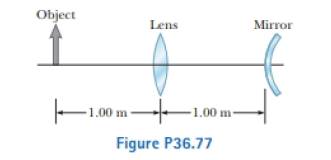
Concept explainers
The lens and mirror in Figure P36.77 are separated by d = 1.00 m and have focal lengths of +80.0 cm and

-50.0 cm, respectively. An object is placed p = 1.00 m to the left of the lens as shown, (a) Locate the final image, formed by light that has gone through the lens twice. (b) Determine the overall magnification of the image and (c) state whether the image is upright or inverted.
(a)
The exact position of the final image formed by light.
Answer to Problem 36.77AP
The exact position of the final image formed by light is
Explanation of Solution
Given info: The object distance from the lens is
Write the expression for the image distance from the lens,
Here,
Substitute
Thus, the image distance from the lens is
This image distance act as an object for the mirror with an object distance of,
Substitute
Write the expression for the image distance from the mirror,
Here,
Substitute
Thus, the image distance from the mirror is
This image distance act as an object for the lens when the light passes through right to left,
The object distance for the lens is,
Substitute
Write the expression for the image distance from the thin lens,
Here,
Substitute
Conclusion:
Therefore, the exact position of the final image formed by light is
(b)
The overall magnification of the image.
Answer to Problem 36.77AP
The overall magnification of the image is
Explanation of Solution
Given info: : The object distance from the lens is
From the part (a) the image distance from the lens is
Formula to calculate the overall magnification is,
Formula to calculate the magnification of lens is,
Formula to calculate the magnification of mirror is,
Formula to calculation the magnification of lens when the light passes through right to left is,
Substitute
Substitute
Conclusion:
Therefore, the overall magnification of the image is
(c)
Whether the image is upright or inverted.
Answer to Problem 36.77AP
The image is inverted.
Explanation of Solution
From part (b) the overall magnification of the image is
Since, the overall magnification of the image is less than zero
Conclusion:
Therefore, the image is inverted.
Want to see more full solutions like this?
Chapter 36 Solutions
EBK PHYSICS FOR SCIENTISTS AND ENGINEER
 Physics for Scientists and EngineersPhysicsISBN:9781337553278Author:Raymond A. Serway, John W. JewettPublisher:Cengage Learning
Physics for Scientists and EngineersPhysicsISBN:9781337553278Author:Raymond A. Serway, John W. JewettPublisher:Cengage Learning Physics for Scientists and Engineers with Modern ...PhysicsISBN:9781337553292Author:Raymond A. Serway, John W. JewettPublisher:Cengage Learning
Physics for Scientists and Engineers with Modern ...PhysicsISBN:9781337553292Author:Raymond A. Serway, John W. JewettPublisher:Cengage Learning Physics for Scientists and Engineers: Foundations...PhysicsISBN:9781133939146Author:Katz, Debora M.Publisher:Cengage Learning
Physics for Scientists and Engineers: Foundations...PhysicsISBN:9781133939146Author:Katz, Debora M.Publisher:Cengage Learning Principles of Physics: A Calculus-Based TextPhysicsISBN:9781133104261Author:Raymond A. Serway, John W. JewettPublisher:Cengage Learning
Principles of Physics: A Calculus-Based TextPhysicsISBN:9781133104261Author:Raymond A. Serway, John W. JewettPublisher:Cengage Learning University Physics Volume 3PhysicsISBN:9781938168185Author:William Moebs, Jeff SannyPublisher:OpenStax
University Physics Volume 3PhysicsISBN:9781938168185Author:William Moebs, Jeff SannyPublisher:OpenStax College PhysicsPhysicsISBN:9781305952300Author:Raymond A. Serway, Chris VuillePublisher:Cengage Learning
College PhysicsPhysicsISBN:9781305952300Author:Raymond A. Serway, Chris VuillePublisher:Cengage Learning





